#c17th
Explore tagged Tumblr posts
Photo

Print by Esaias van Hulsen, plate from a suite of 6 designs for goldsmith's ornament, Dutch, 1617
(via V&A)
63 notes
·
View notes
Text
having to choose a major sucks ass, i just want to be one of those 18th century aristocratic white men who get to write literature and make art on one weekend and study natural science on the next all the while snorting opium
#why does Goethe get to be a polymath for a living and I dont#fucking hell#i know i know its the advance of society making it impossible to be an expert in everything but knowledge has advanced so much#that specific expertise is sorely needed and we all have to commit to one thing or another#but white guys in the c17th got to suck at everything equally and they still made it just fine!!!!#meanwhile nowadays you need a triple phd to work at fucking tescos#hell dimension#sorry im having a moment bc i need to pick uni courses lmao
0 notes
Text
Ooh, a great addition!! I'm not as well up on C16th fashion, so thank you for the context.
Turns out I was partly wrong! Leather jerkins were worn in the 15th and 16th centuries, and buff leather coats were a large part of C16th military armour, though they were often a padding layer under metal. And we DO have extant examples and references to leather hose/breeches/trousers. Huzzah! Precedent!
However, I do think my point stands. Because yes, leather did exist as a garment material - but extremely not how modern designers seem to think.
Compare, for example, The Tudors' Henry VIII or Will's Marlowe above, with actual leather English Renaissance jerkins:



(Worth noting that the left-hand example is described as dark brown, though it's aged into a blacker colour.)
Or The Musketeers with actual C17th buff leather army coats (or, god forbid, actual C17th Mousquetaires du roi):






There's even this leather waistcoat from c. 1714-26, smack bang in the Golden Age of Piracy:

And here are some breeches/trousers I could find, from the late 18th/early 19th centuries:





And, as linked by mstyr, we know that Baron John Petre bought some chamois leather hose from Richard Smithick on Fleet Street in 1577, with lace, silk, and razed/slitted cannions (the narrow part that reached down to the knee). I also found leather jerkins mentioned in that period in the royal wardrobe warrant, including perfumed, or imported Spanish, leather.
Of course, these are all quite fashionable garments, though we should remember that evidence is biased towards the rich. We can probably safely assume the existence of plainer, working people's leather jerkins and trousers/breeches/hose, as well as utilitarian garments like chaps and aprons, for which we don't have a record.
Still: none of these examples look remotely like the ones in modern media, particularly not the generic Vikings/Black Sails/The Tudors look I criticised. If Shakespeare in Love was going for an accurate leather look, they could have given William a brown, cream, or yellow jerkin over a long-sleeved fabric doublet, with some modest (considering his lower status) pinking or slashing. The Musketeers could have given their men high-waisted, yellow or tan buff coats, with big shirts and bright sashes. Arguably, Robin Hood's highly tooled brown leather jerkin has something going for it, but it definitely leans more toward fantasy armour than middle ages fashion, and what they've put Guy in rather undermines the historicism!
It's fairly clear that these modern designs don't come from any attention to extant historical garments or records. And it seems to me that what evidence we do have of historical leather garments doesn't speak to them being particularly common, outweighed as they are by images and examples of wool, linen, silk, and cotton. Leather armour had a brief heyday in the C17th buff coat, but that looked nothing like the leather armour we see in fantasy/period media.
To be clear, my problem with this genre of period costume design isn't just the fact of leather pants. It's generic in plenty of other ways: limited, muted colour palette, often further dulled with dirt (as if people in history didn't have access to cheap, natural dyes, didn't like bright things or fashion, and didn't know how to stay clean); rough, "handmade-look" stitching (as if Vikings, pirates, or English folk heroes didn't have access to highly skilled tailors, leatherworkers, and armourers, or as if, before industrialisation and fast fashion, almost everyone either had, or knew someone with, the skill to neatly make and mend clothing); impractical or anachronistic flourishes (wide, multi-buckled belts; everyday bracers; studs and plates haphazardly attached to anything and everything); high boots on everyone (because no one serious or interesting would wear stockings!); and catering to modern beauty standards with spandex pants, low-cut shirts, and modern hair and makeup (because actors must look as sexy as possible, and audiences can't understand that fashion and beauty standards change over time).
Which is why what Flag does right is not eschew leather entirely, but utilise it with creativity and intention, with context, intertext, and subtext, to create meaning and convey character in complex and nuanced ways.
Still. It is nice to set the record straight on actually historical leather <3
So I accidentally almost got into an argument on Twitter, and now I'm thinking about bad historical costuming tropes. Specifically, Action Hero Leather Pants.
See, I was light-heartedly pointing out the inaccuracies of the costumes in Black Sails, and someone came out of the woodwork to defend the show. The misunderstanding was that they thought I was dismissing the show just for its costumes, which I wasn't - I was simply pointing out that it can't entirely care about material history (meaning specifically physical objects/culture) if it treats its clothes like that.
But this person was slightly offended on behalf of their show - especially, quote, "And from a fan of OFMD, no less!" Which got me thinking - it's true! I can abide a lot more historical costuming inaccuracy from Our Flag than I can Black Sails or Vikings. And I don't think it's just because one has my blorbos in it. But really, when it comes down to it...
What is the difference between this and this?
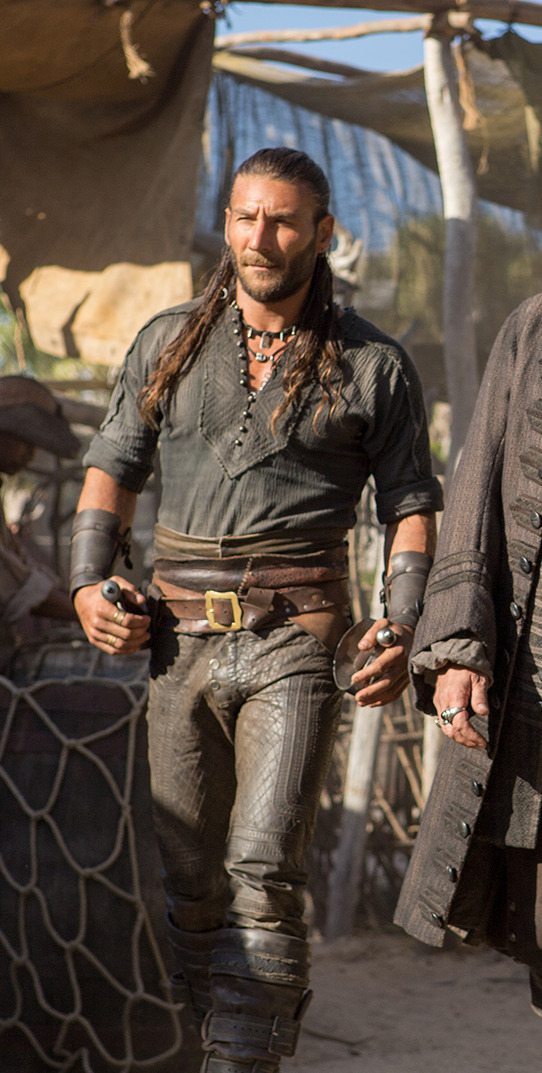
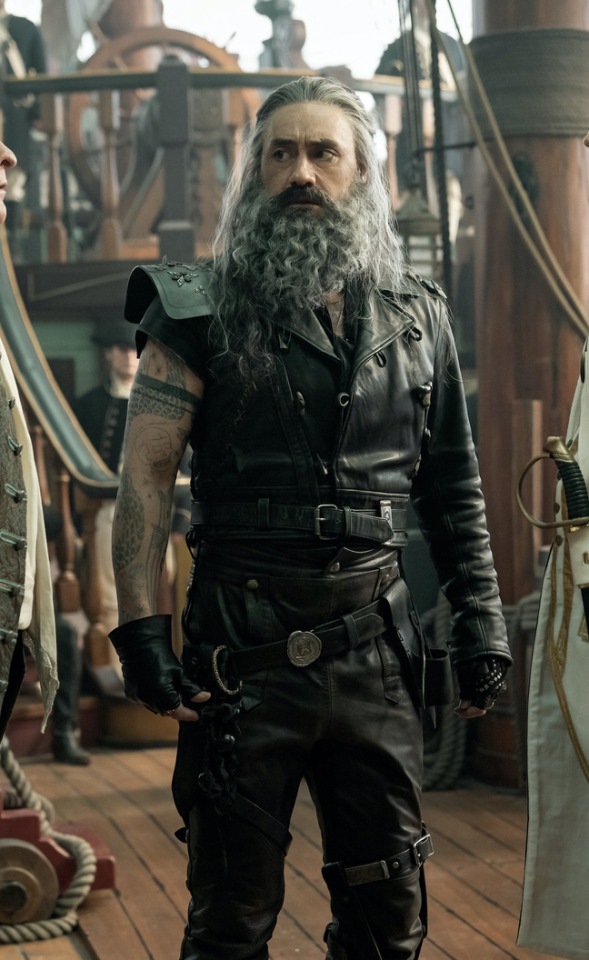
Here's the thing. Leather pants in period dramas isn't new. You've got your Vikings, Tudors, Outlander, Pirates of the Caribbean, Once Upon a Time, Will, The Musketeers, even Shakespeare in Love - they love to shove people in leather and call it a day. But where does this come from?

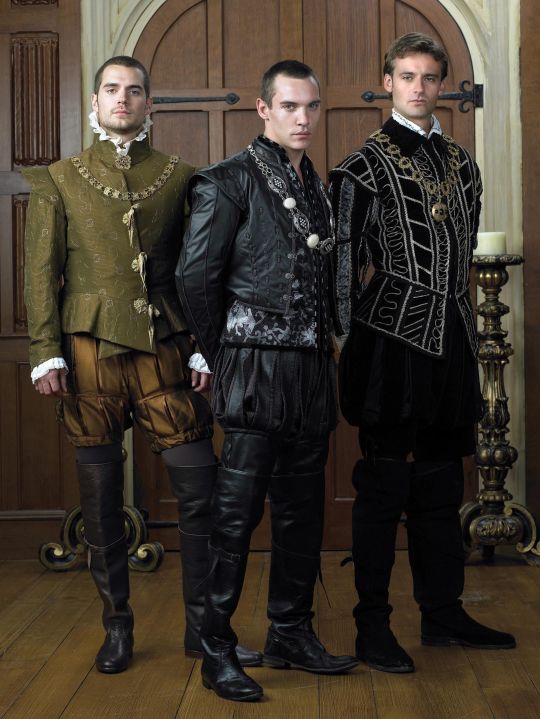
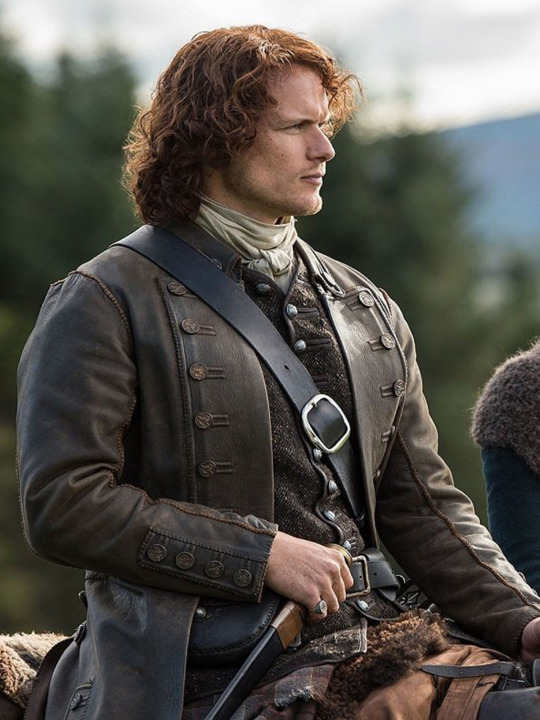

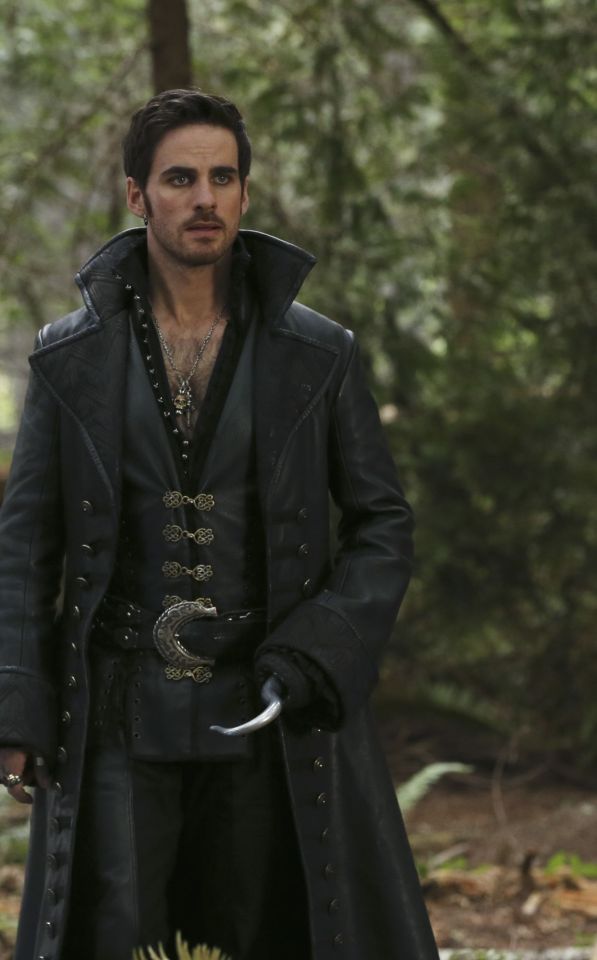


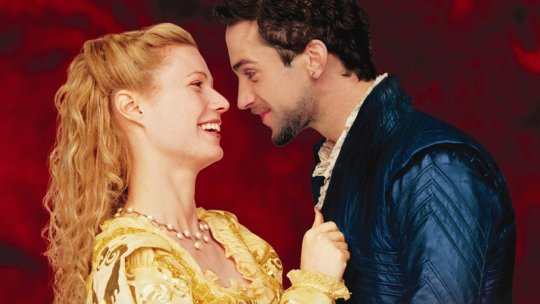
Obviously we have the modern connotations. Modern leather clothes developed in a few subcultures: cowboys drew on Native American clothing. (Allegedly. This is a little beyond my purview, I haven't seen any solid evidence, and it sounds like the kind of fact that people repeat a lot but is based on an assumption. I wouldn't know, though.) Leather was used in some WWI and II uniforms.
But the big boom came in the mid-C20th in motorcycle, punk/goth, and gay subcultures, all intertwined with each other and the above. Motorcyclists wear leather as practical protective gear, and it gets picked up by rock and punk artists as a symbol of counterculture, and transferred to movie designs. It gets wrapped up in gay and kink communities, with even more countercultural and taboo meanings. By the late C20th, leather has entered mainstream fashion, but it still carries those references to goths, punks, BDSM, and motorbike gangs, to James Dean, Marlon Brando, and Mick Jagger. This is whence we get our Spikes and Dave Listers in 1980s/90s media, bad boys and working-class punks.

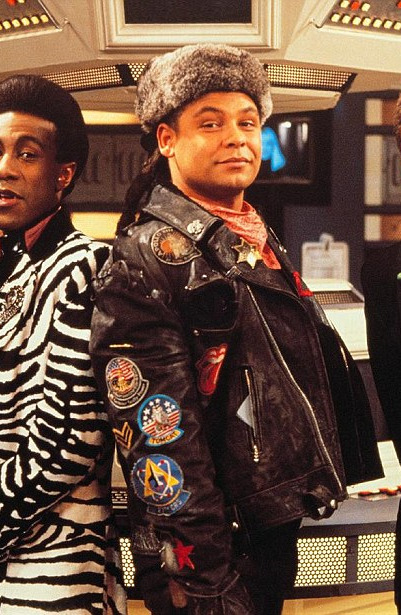
And some of the above "historical" design choices clearly build on these meanings. William Shakespeare is dressed in a black leather doublet to evoke the swaggering bad boy artist heartthrob, probably down on his luck. So is Kit Marlowe.
But the associations get a little fuzzier after that. Hook, with his eyeliner and jewellery, sure. King Henry, yeah, I see it. It's hideously ahistorical, but sure. But what about Jamie and Will and Ragnar, in their browns and shabby, battle-ready chic? Well, here we get the other strain of Bad Period Drama Leather.
See, designers like to point to history, but it's just not true. Leather armour, especially in the western/European world, is very, very rare, and not just because it decays faster than metal. (Yes, even in ancient Greece/Rome, despite many articles claiming that as the start of the leather armour trend!) It simply wasn't used a lot, because it's frankly useless at defending the body compared to metal. Leather was used as a backing for some splint armour pieces, and for belts, sheathes, and buckles, but it simply wasn't worn like the costumes above. It's heavy, uncomfortable, and hard to repair - it's simply not practical for a garment when you have perfectly comfortable, insulating, and widely available linen, wool, and cotton!
As far as I can see, the real influence on leather in period dramas is fantasy. Fantasy media has proliferated the idea of leather armour as the lightweight choice for rangers, elves, and rogues, a natural, quiet, flexible material, less flashy or restrictive than metal. And it is cheaper for a costume department to make, and easier for an actor to wear on set. It's in Dungeons and Dragons and Lord of the Rings, King Arthur, Runescape, and World of Warcraft.
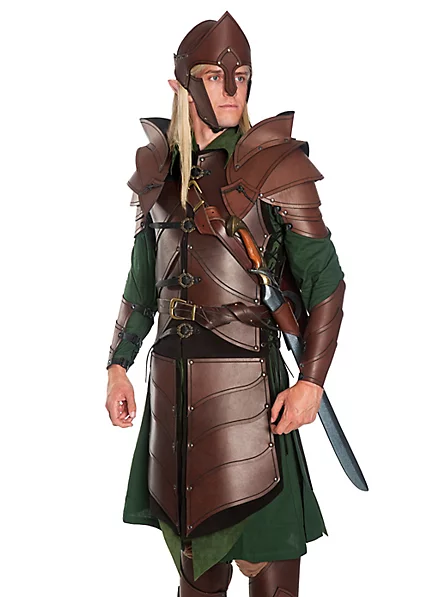
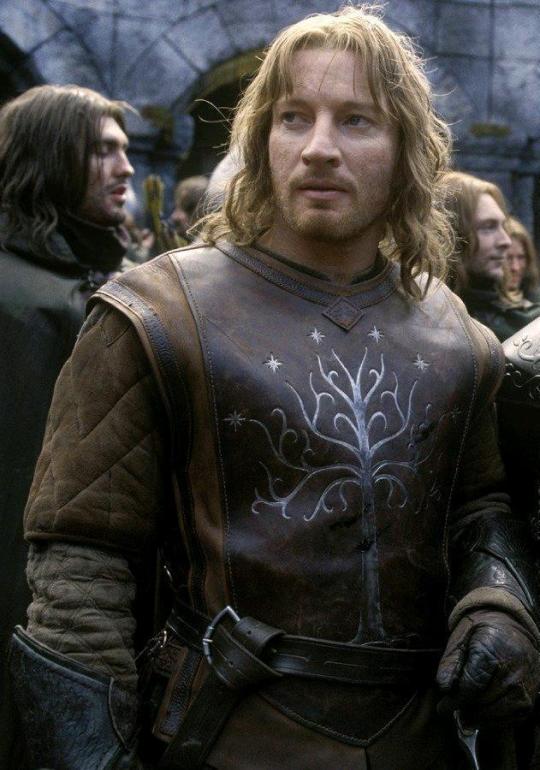
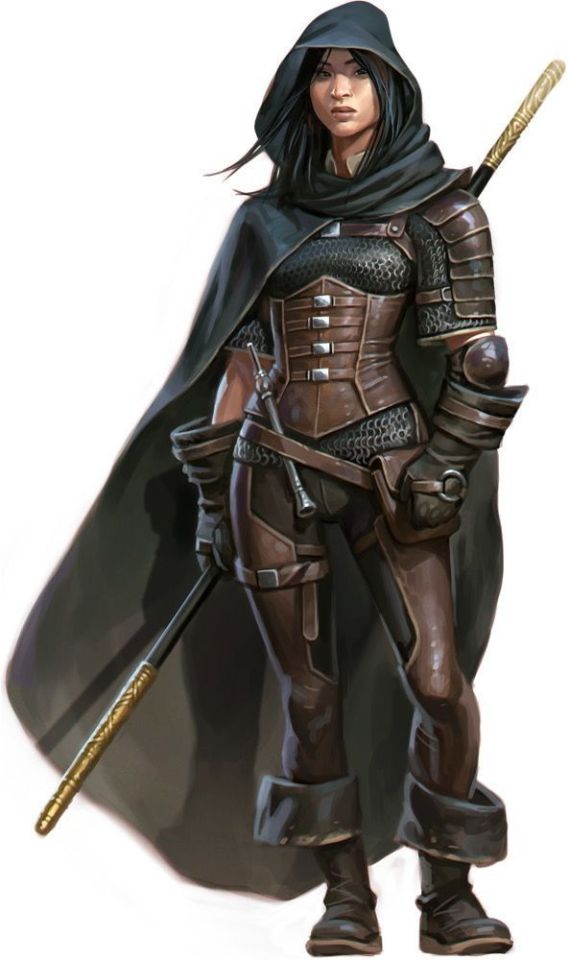
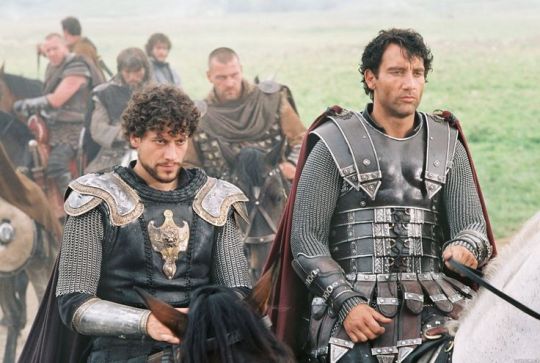

And I think this is how we get to characters like Ragnar and Vane. This idea of leather as practical gear and light armour, it's fantasy, but it has this lineage, behind which sits cowboy chaps and bomber/flight jackets. It's usually brown compared to the punk bad boy's black, less shiny, and more often piecemeal or decorated. In fact, there's a great distinction between the two Period Leather Modes within the same piece of media: Robin Hood (2006)! Compare the brooding, fascist-coded villain Guy of Gisborne with the shabby, bow-wielding, forest-dwelling Robin:
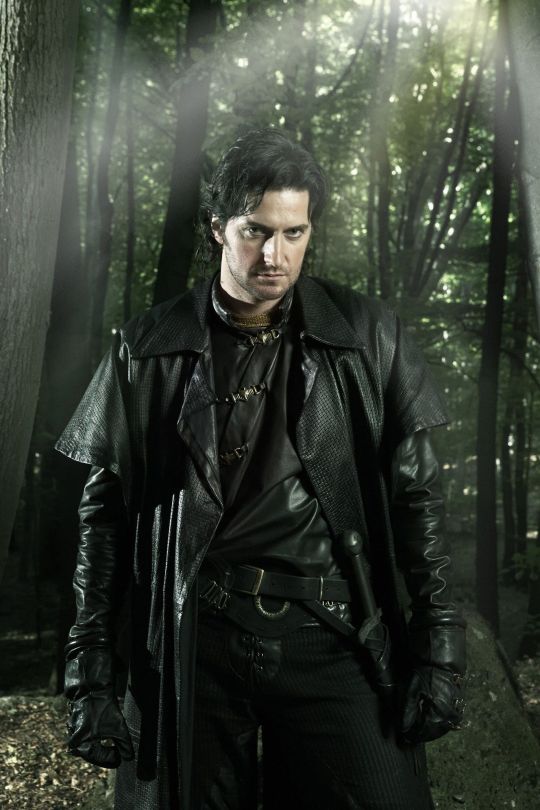

So, back to the original question: What's the difference between Charles Vane in Black Sails, and Edward Teach in Our Flag Means Death?
Simply put, it's intention. There is nothing intentional about Vane's leather in Black Sails. It's not the only leather in the show, and it only says what all shabby period leather says, relying on the same tropes as fantasy armour: he's a bad boy and a fighter in workaday leather, poor, flexible, and practical. None of these connotations are based in reality or history, and they've been done countless times before. It's boring design, neither historically accurate nor particularly creative, but much the same as all the other shabby chic fighters on our screens. He has a broad lineage in Lord of the Rings and Pirates of the Caribbean and such, but that's it.
In Our Flag, however, the lineage is much, much more intentional. Ed is a direct homage to Mad Max, the costuming in which is both practical (Max is an ex-cop and road warrior), and draws on punk and kink designs to evoke a counterculture gone mad to the point of social breakdown, exploiting the thrill of the taboo to frighten and titillate the audience.
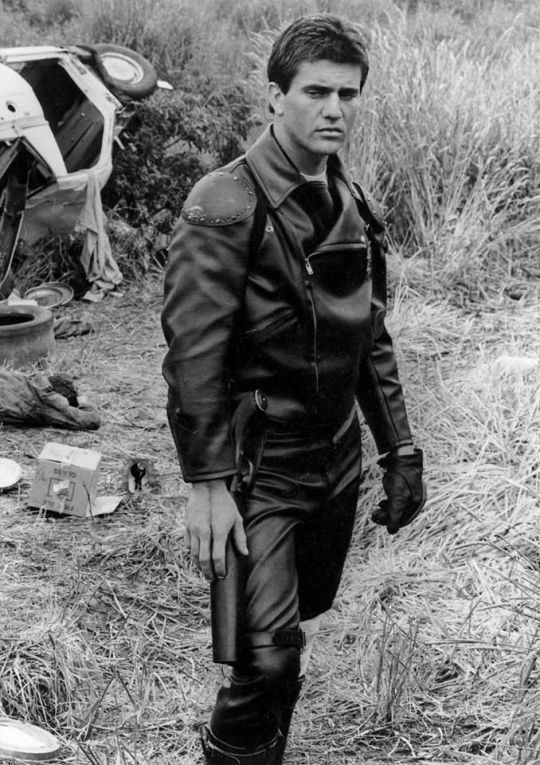
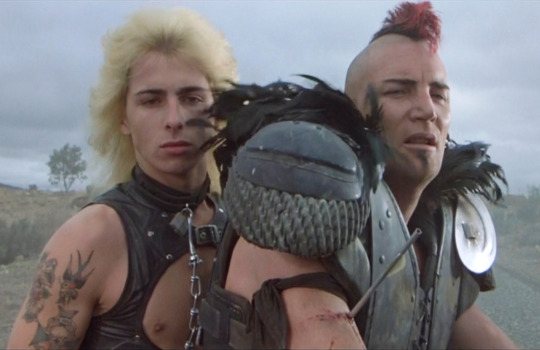
In particular, Ed is styled after Max in the second movie, having lost his family, been badly injured, and watched the world turn into an apocalypse. He's a broken man, withdrawn, violent, and deliberately cutting himself off from others to avoid getting hurt again. The plot of Mad Max 2 is him learning to open up and help others, making himself vulnerable to more loss, but more human in the process.

This ties directly into the themes of Our Flag - it's a deliberate intertext. Ed's emotional journey is also one from isolation and pain to vulnerability, community, and love. Mad Max (intentionally and unintentionally) explores themes of masculinity, violence, and power, while Max has become simplified in the popular imagination as a stoic, badass action hero rather than the more complex character he is, struggling with loss and humanity. Similarly, Our Flag explores masculinity, both textually (Stede is trying to build a less abusive pirate culture) and metatextually (the show champions complex, banal, and tender masculinities, especially when we're used to only seeing pirates in either gritty action movies or childish comedies).
Our Flag also draws on the specific countercultures of motorcycles, rockers, and gay/BDSM culture in its design and themes. Naturally, in such a queer show, one can't help but make the connection between leather pirates and leather daddies, and the design certainly nods at this, with its vests and studs. I always think about this guy, with his flat cap so reminiscient of gay leather fashions.
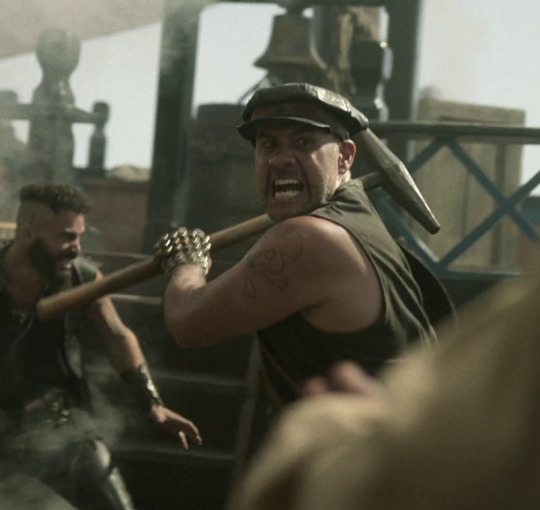
More overtly, though, Blackbeard and his crew are styled as both violent gangsters and countercultural rockstars. They rove the seas like a bikie gang, free and violent, and are seen as icons, bad boys and celebrities. Other pirates revere Blackbeard and wish they could be on his crew, while civilians are awed by his reputation, desperate for juicy, gory details.
This isn't all of why I like the costuming in Our Flag Means Death (especially season 1). Stede's outfits are by no means accurate, but they're a lot more accurate than most pirate media, and they're bright and colourful, with accurate and delightful silks, lace, velvets, and brocades, and lovely, puffy skirts on his jackets. Many of the Revenge crew wear recognisable sailor's trousers, and practical but bright, varied gear that easily conveys personality and flair. There is a surprising dedication to little details, like changing Ed's trousers to fall-fronts for a historical feel, Izzy's puffy sleeves, the handmade fringe on Lucius's red jacket, or the increasing absurdity of navy uniform cuffs between Nigel and Chauncey.
A really big one is the fact that they don't shy away from historical footwear! In almost every example above, we see the period drama's obsession with putting men in skinny jeans and bucket-top boots, but not only does Stede wear his little red-heeled shoes with stockings, but most of his crew, and the ordinary people of Barbados, wear low boots or pumps, and even rough, masculine characters like Pete wear knee breeches and bright colours. It's inaccurate, but at least it's a new kind of inaccuracy, that builds much more on actual historical fashions, and eschews the shortcuts of other, grittier period dramas in favour of colour and personality.
But also. At least it fucking says something with its leather.
#Togas does meta#fashion history#thank you for making me lose an entire evening to researching and writing this (genuine) (it was so much fun)#wouldn't have got there without the starting point you gave me!#like I still remain unconvinced that Vane's weirdly tooled leather pants are even slightly historical. and they're still generic as hell lo#sidenote: sources for all those extant garments are in the alt text#I find the buff waistcoat particularly fascinating - I've looked at a fair few waistcoats from that era and never seen one like it!#which like - yeah I still get the impression that leather garments weren't exactly COMMON until the C20th#with the exception of specific occupational garb like chaps/aprons (and obvs like shoes and gloves and stuff)#and very specific subcultures - iirc the C17th buccaneers are said to have worn pretty rough leather from their work#like yeah the point isn't that 'there are no leather garments in the historical record'#more that a) they're not as common as in period costuming; and b) those designs are still generic; so c) OFMD is still inventive/interestin#BUT. you are still right that my original statements were a bit too sweepingly dismissive#and if you have any other good sources or extant examples please let me know!! <3
1K notes
·
View notes
Text





Aben Danan synagogue, Fez (C17th) (2023)
© optikestrav
5 notes
·
View notes
Text
Guys. We need to talk about THAT KISS and Jane Austen.
No, we do - bear with me.
"If I loved you less, I might be able to talk about it more." (Mr Knightley, hero of Emma by Jane Austen)
So. That Kiss. It's SOOOO messed up, yeah? And Az's expression in the lift veers all over the place, and it's really complex. But WTAF is going on there?
I just had a bit of an epiphany that i thought you might like to share.
So; consider the context.
Aziraphale knows Crowley loves him, yeah? He can FEEL when things are loved (like Tadfield). He considers himself C's partner for life (see that glorious little eyebrow raise when Shax tells him he's not C's type). But he kinda knows that C hasn't quantified it yet, so he does all the things he can to make C think about him as a romantic partner.
He dresses up with some care and puts himself in danger (see how pretty he looks in the French Revolution), then basically arranges himself in a ray of sunlight in picturesque chains till C turns up because he knows how happy it makes C to rescue him (and by the joy on his little face, that's a two way street).
He does nice things for him (where do you think C got the book with all the pics including Alpha Centauri from in S1? He doesn't read books).
He's got all these jolly japes and escapades that he initiates either to bring C joy or to get his attention or whatever. And every damn time C just fails to even consider that there's anything to it other than some sort of accidental humour.
Az doesn't stop there. He does the touchy-feely thing (you almost expect him to say "La, sir!" and hit him with a fan coquettishly) (off topic, I would give actual genuine money to see a C17th genderswapped Az try this). He does every damn thing he can think of to get C to really *see* him...
BUT
HIS DATING MANUAL IS JANE AUSTEN
Bless his angelic cotton socks.
Now in some ways this works quite well. Often the protag's journey in JA culminates in the realisation that though they thought they were unworthy of love, that they actually aren't. Then they get together and it's a whole happy ending.
To Az, this would be absolutely spot on - it would speak to his very heart, yeah?? The "bad" demon who isn't bad would end up with the "good" angel, all's well with the world. They often cock up the first attempt at a proposal, so the fact that it didn't work at the end of S1 is fine because Az is trying to trigger a proposal in S2 with the ball and helping the girls like Emma tries to help Harriet in JA (only thankfully, with better results thanks to a legion of demons).
Az LOVES C, and he knows C loves him but kinda hasn't realised what that means, and he's going all out to find actual romantic love.
BUT let's face it, Az is a total innocent. He'd never read erotica in a month of Sundays, just in case that counts as impure thoughts or something. so the SUM TOTAL of what he knows about how love works, what love is AND CAN BE.... is what's in Jane Austen.
You know what ISN'T in any Jane Austen novel??
Kisses. Yep, you read that right - according to JSTOR (website where academic researchers post stuff) there are ZERO kisses in JA.
There is maybe possibly the implication that someone was kissing before the scene begins in one book, and in Emma there is a shocking and outrageous moment when Mr Elton grabs her hand when proposing (at the time this would have been physically so overfamiliar as to be almost indecent.)
And this is Az's playbook, bless him.
So how does that alter thing?
As far as he's concerned, grabbing C for a dance is the most forward thing he could have done--just look at his face in the moments before, and the whole thing about how his whole hand is intertwined with C, whereas he barely touches the fingertips of the others when dancing (JA etiquette again).
Crowley on the other hand, has been hanging out next to a striptease club in the 70s, and in all sorts of clubs. He's probably a bit Az-centric to have bothered with any shaggery but he has an interested mind and I can absolutely see him reading erotica and chuckling at the lengths humans will go to in search of pleasure. But it wouldn't occur to him that love and sex are that linked, probably, or if it did, only for humans.
So when he gets a talking to by Nina and Maggie, you see Crowley.exe stop working as he starts realising that the whole concept of ROMANTIC LOVE might be applicable to the feeling between himself and Az...
He's absolutely flabbergasted. And then thoughtful. Then a little bit quiet and tentative and it's all set up to be the most beautiful, tender exploration of what could exist between them.... (yeah, thanks for that, Neil).
Then in comes the Metatron like a wrecking ball, and deftly fucks them up.
His proposal is designed to split them apart (which it does) and because he gets in first, that leaves Crowley desperate. He knows that his chance has been lost, so he grabs Az in one horrible, desperate, brutal kiss.
And Az DOESN'T EVEN KNOW ABOUT KISSES.
Az is thinking in terms of a picnic on Box Hill (he tentatively suggests a future picnic when he gives C the holy water in the 70s actually). He thinks it will be a series of lengthy but delicate conversations about how C was perhaps a little too emphatic last time. He's ticked the boxes; there's been the dance, there's been "la sir" and all that malarkey.
He's a little vague on what a proposal actually is if it isn't in a letter (another of JA's irritating habits is to skate over the vital moment) but he thinks that maybe with a little careful curation, he can bring them to this point of happy understanding.
And then, what he gets is THAT KISS.
he doesn't have a fucking clue what it is or what it means, guys, not at first, and he's so SO shocked
He knows how much C loves him; he was expecting/ wanting gentle togetherness (unspecified)but what he got was angry desperation and he doesn't know what to do with that.
Remember in S1 when Crowley goes nose to nose with him in the not-kiss ("I AM NOT NICE!!")? Look at his face when Sister Mary turns up and they don't immediately move. He isn't at all frightened - he does his coy face. Then he spends the next five minutes straightening his clothes, apparently unmoved, and as if he actually rather enjoyed it.
This time he does look scared. He trusts C implicitly but the emotional intensity of the kiss just overloads him totally and so he automatically goes into "i forgive you" mode and it all goes downhill from there. The hand to his lips is part "WTAF was that???" and maybe a little realisation that if it hadn't shocked him so much he might have been open to doing something of the sort again. But he's absolutely floored.
The slightly heartbreaking addition to this is that they both hang around so they can sort it out after the initial shock, but Metatron is wise to that and whisks Az away before he can catch his breath.
Crowley knows how badly he messed up, and he's probably a bit freaked out as well. But when we see Az in the lift, trying not to cry and looking stunned, there's a moment where he suddenly looks deliriously happy. For my money, that's where he realises that the bits Jane Austen left out were probably along these lines, and that Crowley just left out the niceties and cut to the chase (and isn't that so like Crowley??)
And then he has that look of incredulous euphoria he tries to hide from Metatron, as he realises that Crowley wants to kiss him. And that (perhaps in a gentler, kinder way) that he wants to be kissed with that much passion again.
He's just had his whole life handed to him on a plate and simultaneously taken away in the same moment. Yeah, there's stuff he has to do and complications along the way, but God help us when these two get back together. If their love doesn't save the actual universe, I'm gonna be really surprised.
There's a great line at the end of Princess Bride that keeps running through my brain. "“Since the invention of the kiss there have been five kisses that were rated the most passionate, the most pure. This one left them all behind.”
How do you one-up that? Not with THAT kiss, certainly, it was nothing of the sort. The NEXT one though... oh my God. It'll be so good that we're starting to melt now from three years in the past.
I guess we'll find out in a couple of years time in any case- but for now, that's what I'm choosing to look forward to.
:)
#ineffable husbands#ineffable idiots#good omens#good omens 2 spoilers#metatron#aziraphale#crowley#goodomens3#THAT kiss#devil’s in the details
21 notes
·
View notes
Text

6/xx French school c17th century - George Villiers on horseback. Lasalle University collection.
This is interesting as it looks more like 16th century equestrian portraits from France not 17 century England.
Mabye a copy of another work from his 1625 trip to France to collect Henrietta Maria?
#george villiers#duke of buckingham#charles i#james i#henrietta maria#portraits of steenie#steenie#steenie on horseback
5 notes
·
View notes
Text

Pretty, witty Nell
I’ve sworn I’d make a comic about her for ages - I’d totally forgotten about the sketch below, but her appearance hasn’t changed massively between the designs
I knew next to nothing about Nell Gwyn before I started my Mastermind swotting.
At least half of people I mentioned her to hasn’t heard of her, and where she is known it’s usually as being a courtesan (not the word someone used to me) or orange-seller, not as one of the first women on the English stage and whip-sharp comedian with a taste for silver, sky blue satin and massive parties

My books are holed up at my flat whilst I’m holed up at home with a bug, so the research will have to wait and I just console myself with pictures of beautiful C17th dresses
30 notes
·
View notes
Text
A brief history of the Royal Wilding cider apple in two parts. Read it in Cider Musings. #cider #apple #pomology #mysteries https://teepeecider.co.nz/blogs/cider-musings/the-royal-wilding-cider-apple-and-its-history

0 notes
Text
@fotofacade
Love the personality behind these buildings in Ruthin in the gorgeous Vale of Clwyd. They present themselves like the principal characters in a Disney escapade. Porch is late C17th.

2:02 AM · Jun 29, 2024
0 notes
Photo

The monkeys outwitting the bears. Gujarat, India, 1600-1601
(via British Library Images)
35 notes
·
View notes
Text

The fresh green shoots of the tulip bulbs in our garden are sprutting up at a healthy pace. Perhaps I ought to write a piece about 'tulip mania' on here, i.e. the time during the Dutch Golden Age (late C16th to late C17th) when tulip bulbs became ridiculously expensive. I wrote a piece about frankincense in the early days of this blog ADD LINK - at one time it was more precious than gold. I'm also reminded of the unusual hyacinth vases collected by an antique dealer I used to work for - again, could be another interesting subject to write about.
My photo, January 2024.
0 notes
Text
Fyre sent me an article that made me Lose My Mind, so instead of sending 800 tweets about it, I decided to just write up my thoughts here
so, in re: ET Fox, 'Jacobitism and the Golden Age of Piracy' --
Fox is definitely exaggerating. His logic jumps from 'ship names and alleged toasts', to 'every pirate was one contact away from a confirmed Jacobite', to "a Jacobite maritime community" (296), with little evidence beyond each previous assumption. He does demonstrate a link with popular Jacobitism, but overstates pirates' political commitment by far.
There's one letter to George Camocke, a Jacobite naval officer, suggesting that the pirate fleet should unite under his command and take Bermuda as a Jacobite base, but the source is shaky, and it went nowhere once Woodes Rogers ousted the pirates. (It's I think from 1718 and unsigned? Possibly from Charles Vane and his crew? Fox only says that, "Through these contacts [unspecified, between Vane and English Jacobites] a letter reached George Camocke" (286), which is suspiciously vague, and I can't access the original to check. Either way, it would still only prove the committed politics of one crew.)
Fox also makes a lot of Archibald Hamilton, governor of Jamaica from 1710-16, who commissioned and profited from the anti-Spanish privateers who turned pirate and made up some of the original Bahamas pirates c. 1715. Since "it has been suggested that [Hamilton] was a Jacobite supporter" (283), Fox claims that these establishing pirates were also committed Jacobites, and therefore the whole pirate community that grew around them must have been. (Which leads to Fox then being baffled when there's no direct evidence of Jacobitism among some of them, such as the crews of Anstis, Fenn, or Rackham.) He relies on these assumptions, and then claims that every connection between pirates proves their mutual Jacobite sympathies.
It's much more likely (and in line with the historians I've read so far) that the Jacobite toasts and ship names speak to a broader anti-authoritarianism among pirates, with no evidence of committed Jacobite actions by them, eg, specifically targeting Hanoverian ships, or materially supporting or trying to support Jacobite rebels beyond that one letter. Indeed, the 1710s/20s pirates are generally agreed to be distinct for not adhering to religious/national loyalties like the C17th pirates usually did. (I'm so sorry, I haven't consolidated my notes yet, but I know Marcus Rediker goes through this, as does Kris E Lane, and I think Tim Travers and David Cordingly.)
Fox does identify a correlation between the rise and fall of Jacobitism and piracy over the mid/late 1710s, but attributes a pretty shaky causation: pirates ceased their Jacobite loyalties due to the suppression of Jacobitism in Britain and Europe. A much more obvious explanation is that both anti-authoritarian movements simultaneously flourished in the post-war, post-succession instability, then were both quashed as the new regime established itself and cracked down on rebels.
So, did many pirates espouse Jacobite sympathies? Yes! They named their ships in favour of Jacobite causes and rulers, and there are plenty of reports of them toasting to King James / the Pretender. (Which it must be said, although the sheer volume lends a ring of truth to the trend, individual claims should be taken with a grain of salt, as Jacobitism was a common accusation against criminals at the time, with or without a basis.)
Does that mean that the 1710s Caribbean pirate community was centred around a heart of politically committed Jacobites, as Fox argues, or largely motivated by Jacobite sentiments? Yeah, probably not.
Anyway, I am SO sorry that this article got me riled up XD the whole point of this is to say, I've never read anywhere that "many pirates were Jacobites driven out of Britain", which I KNOW wasn't even your main point, but I am unfortunately Insane. We can and should talk about expressions of pro-Jacobitism and actual political engagement among 'Golden Age' pirates, but what we know of their actual actions and espoused ideals doesn't speak to a trend of committed Jacobite politics beyond a general loyalty to rebellious causes.
#history#pirates#pirate history#Jacobites#Jacobitism#Togas does meta#this article annoyed me so much omfg#at every step Fox makes a sort of shaky assumption and then bases his next assumption entirely on that as if it's a proven truth#it's like IF hamilton was a commited jacobite and IF that loyalty was shared with the privateers and IF those privateers#retained and spread that belief among the growing pirate community and IF that was the belief that held the community together#then yeah sure i guess jacobitism was a core cause and concern for the golden age pirates#but that's a lot of fucking 'if's among a situation with a lot more obvious explanations#Fox is right that historians so far are probably ignoring the influence of Jacobitism on golden age pirates a bit#it really hasn't come up in all my reading so far and I've done... a pretty fair amount lol#but he goes so far in the opposite direction that it's kind of embarrassing#very BR Burg coded tbh XD (i say as if i've actually read burg >.> but all the reviews are forming a picture for me...)#EDIT: it's also worth noting that Jacobitism was rarely (never?) a charge laid against pirates in all the trials and moralising against them#which you'd think - if they were actually hardcore individual or broad-base supporters of the cause - might've come up more often#but anti-pirate arguments basically always revolve around the threat to trade and property therefore nation/empire#if lawyers and reverends wanted to argue that pirates were traitors - and they did! - you'd think they'd mention any actual treasons#EDIT EDIT: N: Harry M. Lewis (2021) George Camocke’s 1718 Proposal of a Jacobite–Pirate Alliance#The Mariner's Mirror 107:3 pp366-370#has better detail and context for that letter
6 notes
·
View notes
Text









Chapel of the bones, Évora (C17th) (2023)
Igreja de São Francisco, Capela dos Ossos
© optikestrav
2 notes
·
View notes
Text
SELF-PORTRAITS FROM C17th TO C21st
0 notes
Link
A superb 17th century Flemish tapestry in wool and silk probably from the Wauters manufacture, recognisable and characterised by the relative quality of the author of the cartoons of this workshop, representing Ulysses and Diomedes taking possession of the statuette of Pallas.
0 notes
